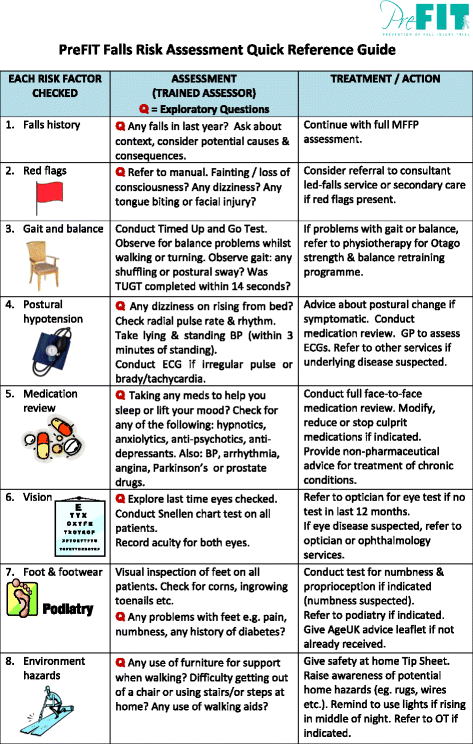Unknown Facts About Dementia Fall Risk
Unknown Facts About Dementia Fall Risk
Blog Article
Some Known Details About Dementia Fall Risk
Table of ContentsGetting The Dementia Fall Risk To WorkThe Basic Principles Of Dementia Fall Risk Dementia Fall Risk Fundamentals ExplainedThe Buzz on Dementia Fall Risk
A loss danger evaluation checks to see how most likely it is that you will certainly fall. It is primarily provided for older adults. The evaluation normally consists of: This includes a collection of inquiries regarding your total health and wellness and if you have actually had previous drops or issues with balance, standing, and/or walking. These tools evaluate your strength, equilibrium, and stride (the means you walk).Treatments are recommendations that may lower your danger of dropping. STEADI includes three steps: you for your risk of dropping for your danger elements that can be enhanced to try to stop drops (for instance, equilibrium problems, impaired vision) to minimize your risk of dropping by making use of reliable methods (for instance, giving education and learning and resources), you may be asked numerous concerns including: Have you dropped in the past year? Are you fretted regarding falling?
If it takes you 12 secs or even more, it might mean you are at higher threat for a fall. This examination checks toughness and balance.
Relocate one foot midway onward, so the instep is touching the large toe of your various other foot. Move one foot fully in front of the various other, so the toes are touching the heel of your various other foot.
All About Dementia Fall Risk
A lot of drops occur as a result of multiple contributing factors; for that reason, taking care of the threat of falling starts with determining the factors that contribute to drop threat - Dementia Fall Risk. A few of one of the most relevant risk aspects consist of: Background of prior fallsChronic clinical conditionsAcute illnessImpaired gait and equilibrium, reduced extremity weaknessCognitive impairmentChanges in visionCertain risky medications and polypharmacyEnvironmental variables can also increase the risk for falls, consisting of: Inadequate lightingUneven or damaged flooringWet or slippery floorsMissing or harmed hand rails and grab barsDamaged or incorrectly fitted equipment, such as beds, wheelchairs, or walkersImproper usage of assistive devicesInadequate guidance of individuals living in the NF, including those who show hostile behaviorsA effective loss risk administration program requires a comprehensive professional evaluation, with input from all participants of the interdisciplinary group

The treatment plan should also consist of interventions that are system-based, such as those that promote a secure environment (ideal lighting, hand rails, order bars, etc). The effectiveness of the interventions need to be examined occasionally, and the treatment plan modified as needed to reflect changes in the loss threat analysis. Applying a loss threat monitoring system utilizing evidence-based best practice can reduce the occurrence click site of falls find more in the NF, while restricting the capacity for fall-related injuries.
The 30-Second Trick For Dementia Fall Risk
The AGS/BGS guideline recommends evaluating all grownups aged 65 years and older for loss threat yearly. This testing contains asking people whether they have dropped 2 or even more times in the previous year or looked for medical attention for a fall, or, if they have not fallen, whether they feel unstable when walking.
People who have actually fallen when without injury needs to have their balance and stride evaluated; those with gait or equilibrium abnormalities need to get extra analysis. A background of 1 autumn without injury and without stride or equilibrium troubles does not require additional evaluation beyond continued annual autumn threat screening. Dementia Fall Risk. A fall danger analysis is needed as component of the Welcome to Medicare evaluation

Facts About Dementia Fall Risk Uncovered
Documenting a falls background is one of the high quality indicators for loss avoidance and monitoring. Psychoactive drugs in particular are independent predictors of drops.
Postural hypotension can frequently be eased by decreasing the dose of blood pressurelowering drugs and/or stopping medications that have orthostatic hypotension as a negative effects. Use above-the-knee assistance hose pipe and sleeping with the head of the bed raised might likewise decrease postural decreases in high blood pressure. The recommended elements of a fall-focused health examination are received Box 1.

A TUG time greater than or equal to 12 seconds recommends high fall risk. Being not able to stand up from a chair of knee height without using one's arms suggests enhanced loss danger.
Report this page